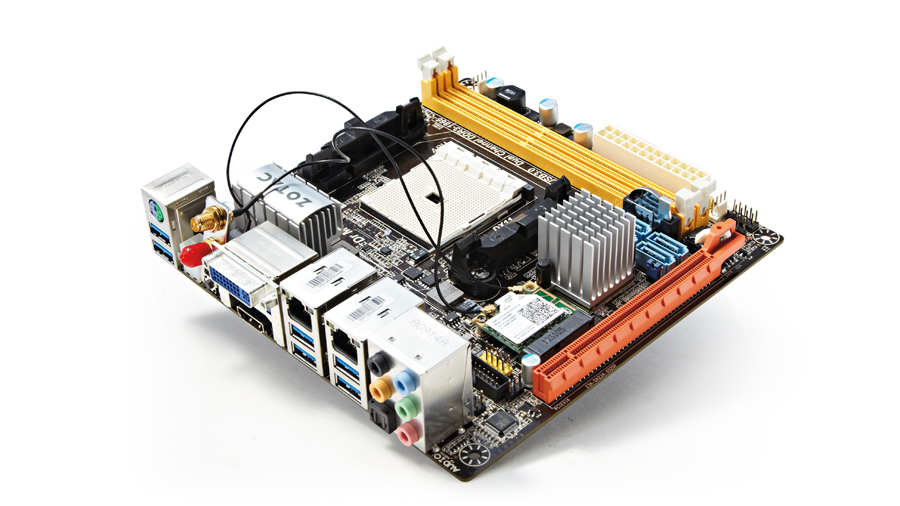TechRadar Verdict
Pros
- +
Improved graphics courtesy of Trinity APUs
- +
Upgraded memory support to 16GB
- +
No trouble competing with full-sized boards
Cons
- -
No mouse support in UEFI BIOS
- -
Not many overclocking options
Why you can trust TechRadar
The mini-ITX mobo has definitely come of age. In fact, ever since board designers decided to ditch those mobile components that blighted the format so and instead picked the best mainstream desktop components, the tiny format has never looked back.
When it comes to mini-ITX boards, Zotac is a major player. It offers boards supporting the latest CPU technology - in Intel and AMD trim - and we've reviewed a number of them, including this board's predecessor.
The original A-Series supported AMD's first generation FM1 socket, which in turn supported the original A-series Llano APUs. The A75-ITX WiFi B-Series though offers support for AMD's Trinity APUs using the newer FM2 socket.
From the outside, the new board looks identical to the A-Series, but under the skin there are a couple important advancements. The Trinity core brings with it improved Radeon HD7xxx series integrated graphics, and support for DDR3 to speeds of 1,866MHz (depending on the APU).
Interestingly, the first A-Series board only supported a maximum 8GB of memory via its two DIMM slots, whereas the quoted maximum for the B-Series board is 16GB. For AMD's APUs, memory capacity, bandwidth and speed are important factors for performance - especially in terms of the graphical speeds. This updated A75 board's boosted RAM is therefore an important enhancement.
Technical analysis
To test the Zotac A-75-ITX WiFi B-Series, we used the A10 5800K Trinity CPU with a Zalman CNPS 8000B top fan cooler. For memory we used 16GB of Crucial's new Ballistix Tactical Low Profile 1600MHz DDR3. This memory is extremely useful - it fitted easily into the DIMM slots, even with the compact cooler in place.
Benchmarks
CPU rendering performance
Cinebench R11.5: Index score: Higher is better
ZOTAC A75 B-SERIES: 3.31
SAPPHIRE A85XT: 3.21
ASUS F2A85-V PRO: 3.16
Memory bandwidth performance
SiSoft Sandra: GB/S: Higher is better
ZOTAC A75 B-SERIES: 13.0
SAPPHIRE A85XT: 12.9
ASUS F2A85-V PRO: 10.5
CPU encoding performance
X264: FPS: Higher is better
ZOTAC A75 B-SERIES: 21
SAPPHIRE A85XT: 20
ASUS F2A85-V PRO: 21
Mighty mini-ITX
The benchmarks show just how impressive these tiny boards are. The wee Zotac has no trouble keeping up with the Sapphire Pure Platinum A85XT or the Asus F2A85-V Pro (full sized FM2 boards), or the Asus Sabertooth Z77 with an Intel i3 CPU in it.
The other thing about the Trinity APU is the integrated graphics performance. We tested it with a Radeon HD 6850 in the Batman: Arkham City benchmark at 1080p, which gave a result of 60fps. When we tested the integrated HD 7660D core of the A10-5800K we used for benching, we got a playable 30fps at the same HD resolution. For an integrated solution that's damned good.
The BIOS looks like it might be a UEFI-based one, but it doesn't have any mouse support. It's a bit light on overclocking options too - just a couple of memory speed and voltage tweaks. But in Zotac's defence, these boards aren't about overclocking, they're about putting together a powerful system in the smallest possible space.
The small format does force some compromises. You only get one PCIe slot and two DIMM slots, but if you think about it, how many tower systems are out there with full size motherboards and only two DIMM slots used? Or, for that matter, housing a single graphics card?
If you're looking a tiny board as the basis of a gaming-capable machine sans discrete graphics, the A75 B-series is a great choice. And if your little chassis has enough space, then a cheapo GPU paired up in hybrid CrossFireX mode could get you an impressive wee gaming PC.
